

 Ford. Editor-in-Chief's Note: This qualifies as big news around these parts: The Michigan Central Station, which was vacant for years and a forlorn symbol of the downtrodden city of Detroit, has been sold to the Ford Motor Company. The plan is to revitalize the iconic building - yes, the blue oval will be prominent on it - as the hub of Ford's Corktown campus focused on advanced automotive technology. Matthew Moroun, whose family enterprise has owned the station since 1996, announced the sale Monday morning in front of the historic structure. Congratulations to Ford, now the tough - and lengthy - rehab job begins. -PMD
Ford. Editor-in-Chief's Note: This qualifies as big news around these parts: The Michigan Central Station, which was vacant for years and a forlorn symbol of the downtrodden city of Detroit, has been sold to the Ford Motor Company. The plan is to revitalize the iconic building - yes, the blue oval will be prominent on it - as the hub of Ford's Corktown campus focused on advanced automotive technology. Matthew Moroun, whose family enterprise has owned the station since 1996, announced the sale Monday morning in front of the historic structure. Congratulations to Ford, now the tough - and lengthy - rehab job begins. -PMD
Editor-in-Chief's Note: Series production of the first purely electric Porsche is set to begin sometime in 2019. The vehicle, previously operating under the working title "Mission E" has now been given its official name: Taycan. The Eurasian name can be roughly translated as "lively young horse," referencing the imagery at the heart of the Porsche crest, which has featured a leaping steed since 1952. That Porsche came up with a strange name instead of a number is yet another case of "Why ask why?" And so it goes. -PMD
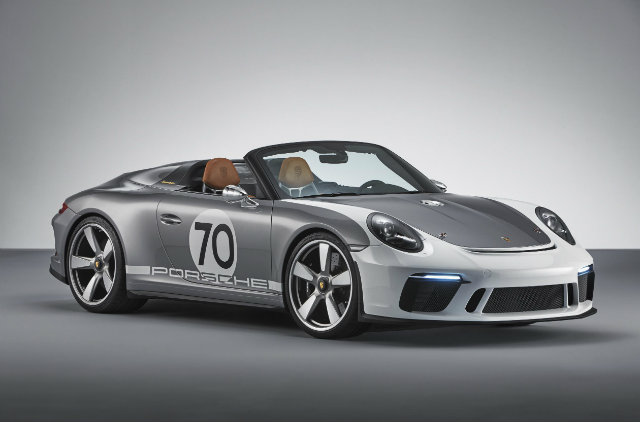
(Porsche images)
Porsche has unveiled a 911 Speedster Concept as part of the 70th anniversary of its sports cars. It links the very first Porsche 356 “No. 1” Roadster, which received its operating permit on June 8, 1948, with today’s Porsche cars. The purist concept and historically accurate execution of the 911 Speedster Concept "emphasize a pure driving experience," according to Porsche. The 911 Speedster Concept was unveiled as part of the official “70 years of Porsche Sports Cars” anniversary celebration in Stuttgart-Zuffenhausen.
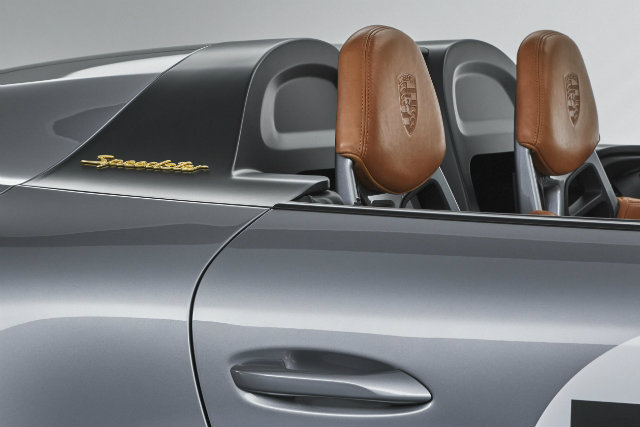 The details of the 911 Speedster Concept include a shorter windshield frame with a steeper windscreen angle and shorter side windows.
The details of the 911 Speedster Concept include a shorter windshield frame with a steeper windscreen angle and shorter side windows.
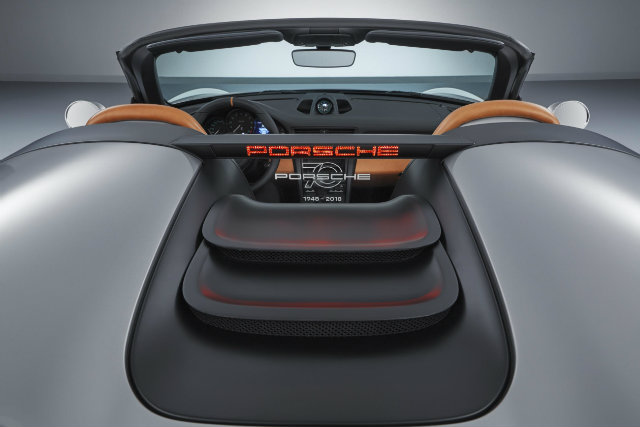 A special rear decklid made of carbon fiber connects behind the front seats, covering supplemental safety bars and featuring two “streamliners,” a traditional element of this sports car design since the first 911 Speedster was introduced in 1988. Two contrasting black slats between the “streamliners” add an aerodynamic touch, and a transparent Plexiglas™ wind deflector features an etched ‘70 years of Porsche’ logo.
A special rear decklid made of carbon fiber connects behind the front seats, covering supplemental safety bars and featuring two “streamliners,” a traditional element of this sports car design since the first 911 Speedster was introduced in 1988. Two contrasting black slats between the “streamliners” add an aerodynamic touch, and a transparent Plexiglas™ wind deflector features an etched ‘70 years of Porsche’ logo.
 The 911 Speedster Concept also features a lightweight tonneau cover in place of a convertible top. This cover protects the interior from rain when parked and is attached using eight Tenax™ fasteners. The navigation, radio and air conditioning systems have all been removed to reduce weight. The Full Bucket Seats are made of carbon fiber and finished in light brown natural leather in Cognac.
The 911 Speedster Concept also features a lightweight tonneau cover in place of a convertible top. This cover protects the interior from rain when parked and is attached using eight Tenax™ fasteners. The navigation, radio and air conditioning systems have all been removed to reduce weight. The Full Bucket Seats are made of carbon fiber and finished in light brown natural leather in Cognac.
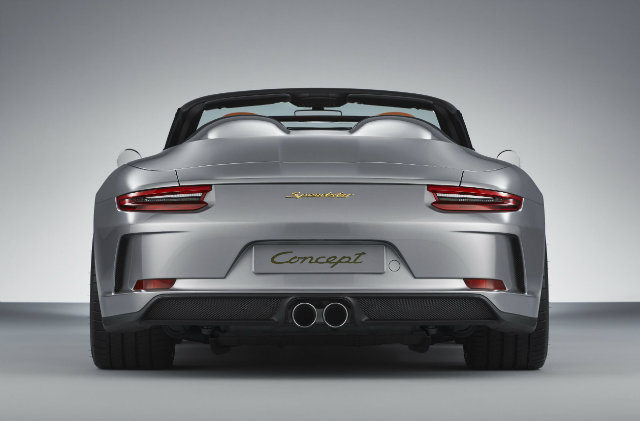 The body of the concept car was adopted from the 911 Carrera 4 Cabriolet. The fenders, front trunk lid and the rear decklid cover of the concept are made of light-weight carbon fiber reinforced polymer composite material. The wide B-pillars and the rear fascia are decorated with milled, gold-plated Speedster lettering.
The body of the concept car was adopted from the 911 Carrera 4 Cabriolet. The fenders, front trunk lid and the rear decklid cover of the concept are made of light-weight carbon fiber reinforced polymer composite material. The wide B-pillars and the rear fascia are decorated with milled, gold-plated Speedster lettering.
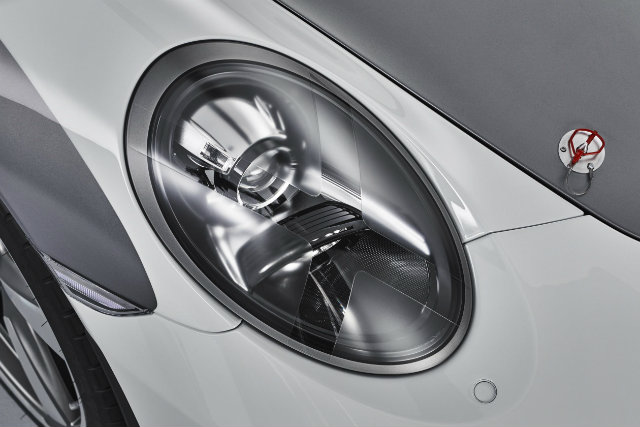 Traditional GT Silver Metallic and White paintwork harks back to Porsche’s early race cars – as do many of the other carefully crafted details, such as the 50s-style central fuel tank cap positioned in the front trunk lid, the classic Talbot® shape of the exterior mirrors or the unique design of the headlights. Transparent and opaque surfaces on the headlight covers resemble the shape of an “X” and are a nod to a practice prevalent in Porsche’s early years in motorsport. At the time, the headlights were taped up before races to protect them against stone chipping and to prevent the glass from shattering.
Traditional GT Silver Metallic and White paintwork harks back to Porsche’s early race cars – as do many of the other carefully crafted details, such as the 50s-style central fuel tank cap positioned in the front trunk lid, the classic Talbot® shape of the exterior mirrors or the unique design of the headlights. Transparent and opaque surfaces on the headlight covers resemble the shape of an “X” and are a nod to a practice prevalent in Porsche’s early years in motorsport. At the time, the headlights were taped up before races to protect them against stone chipping and to prevent the glass from shattering.
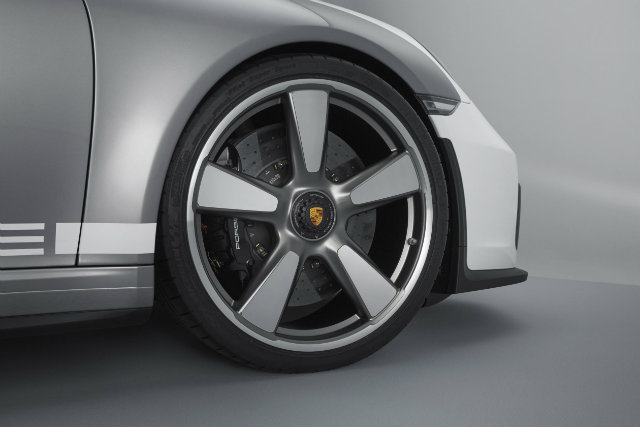 The chassis is from the 911 GT3 and the 21-inch Fuchs-design rims with contrasting high gloss polished petals details are unique to the 911 Speedster Concept. It is the first time that Fuchs-design wheels have been fitted with center locks. The GT development department also supplies the exhaust system with titanium tailpipes and the powertrain, which includes a six-speed manual transmission. The naturally aspirated flat-six engine in this minimalist concept study delivers over 500HP and revs up to 9,000 rpm.
The chassis is from the 911 GT3 and the 21-inch Fuchs-design rims with contrasting high gloss polished petals details are unique to the 911 Speedster Concept. It is the first time that Fuchs-design wheels have been fitted with center locks. The GT development department also supplies the exhaust system with titanium tailpipes and the powertrain, which includes a six-speed manual transmission. The naturally aspirated flat-six engine in this minimalist concept study delivers over 500HP and revs up to 9,000 rpm.
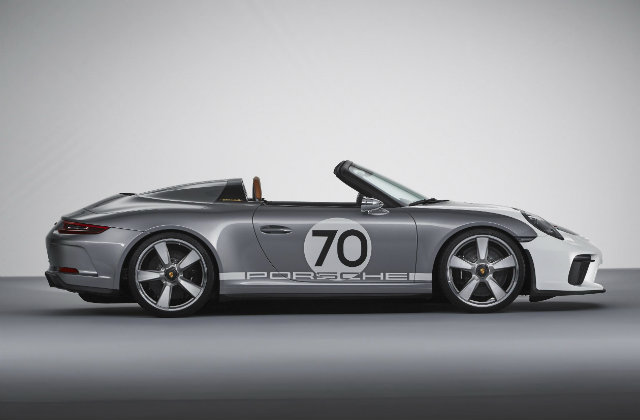 The history of Porsche Speedster models began in the United States. Speedster variants of sports car models have been part of the Porsche company history since 1952. The forefather of Porsche Speedster models, the 356 1500 America Roadster, had an aluminum body manufactured entirely by hand. It weighed about 130 pounds (60 kilograms) less than the 356 Coupe and its top track speed of 108 miles per hour (175 km/h) with its 70-hp four-cylinder flat engine was impressive at the time. Featuring slot-in curtain windows for the doors, a folding top and lightweight bucket seats, this car developed exclusively for the US market was built just 16 times and already embodied several key elements of the Speedster design.
The history of Porsche Speedster models began in the United States. Speedster variants of sports car models have been part of the Porsche company history since 1952. The forefather of Porsche Speedster models, the 356 1500 America Roadster, had an aluminum body manufactured entirely by hand. It weighed about 130 pounds (60 kilograms) less than the 356 Coupe and its top track speed of 108 miles per hour (175 km/h) with its 70-hp four-cylinder flat engine was impressive at the time. Featuring slot-in curtain windows for the doors, a folding top and lightweight bucket seats, this car developed exclusively for the US market was built just 16 times and already embodied several key elements of the Speedster design.
Porsche has unveiled a 911 Speedster Concept as part of the 70th anniversary of its sports cars. It links the very first Porsche 356 “No. 1” Roadster, which received its operating permit on June 8, 1948, with today’s Porsche cars. The purist concept and historically accurate execution of the 911 Speedster Concept "emphasize a pure driving experience," according to Porsche. The 911 Speedster Concept was unveiled as part of the official “70 years of Porsche Sports Cars” anniversary celebration in Stuttgart-Zuffenhausen.
 The details of the 911 Speedster Concept include a shorter windshield frame with a steeper windscreen angle and shorter side windows.
The details of the 911 Speedster Concept include a shorter windshield frame with a steeper windscreen angle and shorter side windows.  A special rear decklid made of carbon fiber connects behind the front seats, covering supplemental safety bars and featuring two “streamliners,” a traditional element of this sports car design since the first 911 Speedster was introduced in 1988. Two contrasting black slats between the “streamliners” add an aerodynamic touch, and a transparent Plexiglas™ wind deflector features an etched ‘70 years of Porsche’ logo.
A special rear decklid made of carbon fiber connects behind the front seats, covering supplemental safety bars and featuring two “streamliners,” a traditional element of this sports car design since the first 911 Speedster was introduced in 1988. Two contrasting black slats between the “streamliners” add an aerodynamic touch, and a transparent Plexiglas™ wind deflector features an etched ‘70 years of Porsche’ logo. The 911 Speedster Concept also features a lightweight tonneau cover in place of a convertible top. This cover protects the interior from rain when parked and is attached using eight Tenax™ fasteners. The navigation, radio and air conditioning systems have all been removed to reduce weight. The Full Bucket Seats are made of carbon fiber and finished in light brown natural leather in Cognac.
The 911 Speedster Concept also features a lightweight tonneau cover in place of a convertible top. This cover protects the interior from rain when parked and is attached using eight Tenax™ fasteners. The navigation, radio and air conditioning systems have all been removed to reduce weight. The Full Bucket Seats are made of carbon fiber and finished in light brown natural leather in Cognac. The body of the concept car was adopted from the 911 Carrera 4 Cabriolet. The fenders, front trunk lid and the rear decklid cover of the concept are made of light-weight carbon fiber reinforced polymer composite material. The wide B-pillars and the rear fascia are decorated with milled, gold-plated Speedster lettering.
The body of the concept car was adopted from the 911 Carrera 4 Cabriolet. The fenders, front trunk lid and the rear decklid cover of the concept are made of light-weight carbon fiber reinforced polymer composite material. The wide B-pillars and the rear fascia are decorated with milled, gold-plated Speedster lettering. Traditional GT Silver Metallic and White paintwork harks back to Porsche’s early race cars – as do many of the other carefully crafted details, such as the 50s-style central fuel tank cap positioned in the front trunk lid, the classic Talbot® shape of the exterior mirrors or the unique design of the headlights. Transparent and opaque surfaces on the headlight covers resemble the shape of an “X” and are a nod to a practice prevalent in Porsche’s early years in motorsport. At the time, the headlights were taped up before races to protect them against stone chipping and to prevent the glass from shattering.
Traditional GT Silver Metallic and White paintwork harks back to Porsche’s early race cars – as do many of the other carefully crafted details, such as the 50s-style central fuel tank cap positioned in the front trunk lid, the classic Talbot® shape of the exterior mirrors or the unique design of the headlights. Transparent and opaque surfaces on the headlight covers resemble the shape of an “X” and are a nod to a practice prevalent in Porsche’s early years in motorsport. At the time, the headlights were taped up before races to protect them against stone chipping and to prevent the glass from shattering.  The chassis is from the 911 GT3 and the 21-inch Fuchs-design rims with contrasting high gloss polished petals details are unique to the 911 Speedster Concept. It is the first time that Fuchs-design wheels have been fitted with center locks. The GT development department also supplies the exhaust system with titanium tailpipes and the powertrain, which includes a six-speed manual transmission. The naturally aspirated flat-six engine in this minimalist concept study delivers over 500HP and revs up to 9,000 rpm.
The chassis is from the 911 GT3 and the 21-inch Fuchs-design rims with contrasting high gloss polished petals details are unique to the 911 Speedster Concept. It is the first time that Fuchs-design wheels have been fitted with center locks. The GT development department also supplies the exhaust system with titanium tailpipes and the powertrain, which includes a six-speed manual transmission. The naturally aspirated flat-six engine in this minimalist concept study delivers over 500HP and revs up to 9,000 rpm. The history of Porsche Speedster models began in the United States. Speedster variants of sports car models have been part of the Porsche company history since 1952. The forefather of Porsche Speedster models, the 356 1500 America Roadster, had an aluminum body manufactured entirely by hand. It weighed about 130 pounds (60 kilograms) less than the 356 Coupe and its top track speed of 108 miles per hour (175 km/h) with its 70-hp four-cylinder flat engine was impressive at the time. Featuring slot-in curtain windows for the doors, a folding top and lightweight bucket seats, this car developed exclusively for the US market was built just 16 times and already embodied several key elements of the Speedster design.
The history of Porsche Speedster models began in the United States. Speedster variants of sports car models have been part of the Porsche company history since 1952. The forefather of Porsche Speedster models, the 356 1500 America Roadster, had an aluminum body manufactured entirely by hand. It weighed about 130 pounds (60 kilograms) less than the 356 Coupe and its top track speed of 108 miles per hour (175 km/h) with its 70-hp four-cylinder flat engine was impressive at the time. Featuring slot-in curtain windows for the doors, a folding top and lightweight bucket seats, this car developed exclusively for the US market was built just 16 times and already embodied several key elements of the Speedster design.
(Ford images)
Ford Performance engineers and designers incorporated the latest advances in tire, aerodynamics and chassis technology to improve the 2019 Mustang Shelby GT350. Greater precision and overall balance in order to deliver faster lap times and performance on-track and on the street were the goals. 2019 Mustang Shelby GT350 performance enhancements include improved aerodynamics that reduce drag with the new spoiler and add downforce with new available Gurney flap installed, plus chassis and antilock brake tuning for dramatically greater grip. Working exclusively with Michelin, the team also engineered new Michelin Pilot Sport Cup 2 tires with a Shelby GT350-specific tread pattern and different compound to deliver more grip for significantly improved acceleration and lateral acceleration, as well as braking. The 295/35 front and 305/35 rear tires are fitted to improved stiffness and optimize new 19-inch aluminum wheels. The Shelby GT350 benefits from Ford Performance Mustang road course racing experience and Shelby GT500 aerodynamic advancements, plus hundreds of hours of on-track and full vehicle simulations; Billy Johnson, Ford GT World Endurance driver, helped dial in final performance tuning. The 2019 Mustang Shelby GT350 will be available starting in early 2019 and will be built at Flat Rock Assembly Plant in Flat Rock, Michigan. Enrollment in an exclusive, complimentary Track Attack driving program from Ford Performance is included with each vehicle.
Ford Performance engineers and designers incorporated the latest advances in tire, aerodynamics and chassis technology to improve the 2019 Mustang Shelby GT350. Greater precision and overall balance in order to deliver faster lap times and performance on-track and on the street were the goals. 2019 Mustang Shelby GT350 performance enhancements include improved aerodynamics that reduce drag with the new spoiler and add downforce with new available Gurney flap installed, plus chassis and antilock brake tuning for dramatically greater grip. Working exclusively with Michelin, the team also engineered new Michelin Pilot Sport Cup 2 tires with a Shelby GT350-specific tread pattern and different compound to deliver more grip for significantly improved acceleration and lateral acceleration, as well as braking. The 295/35 front and 305/35 rear tires are fitted to improved stiffness and optimize new 19-inch aluminum wheels. The Shelby GT350 benefits from Ford Performance Mustang road course racing experience and Shelby GT500 aerodynamic advancements, plus hundreds of hours of on-track and full vehicle simulations; Billy Johnson, Ford GT World Endurance driver, helped dial in final performance tuning. The 2019 Mustang Shelby GT350 will be available starting in early 2019 and will be built at Flat Rock Assembly Plant in Flat Rock, Michigan. Enrollment in an exclusive, complimentary Track Attack driving program from Ford Performance is included with each vehicle.


